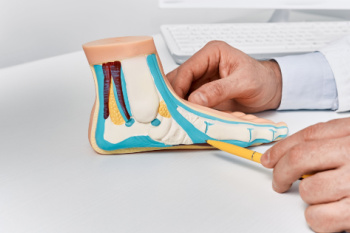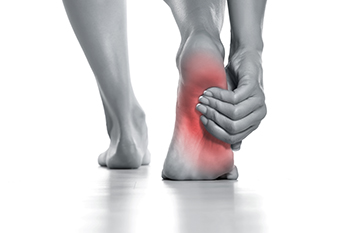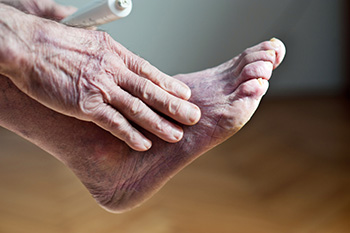Items filtered by date: July 2025
Understanding Plantar Heel Pain

Plantar heel pain affects people of all ages, although it tends to occur more often in adults. This type of pain typically develops under the heel and may feel sharp or aching, often worsening with the first steps in the morning or after long periods of rest. Several factors can increase your chances of developing plantar heel pain, including excess weight, health conditions like high blood pressure, or simply the natural aging process. Women may experience plantar heel pain more frequently than men, possibly due to differences in foot structure or footwear habits. Conditions like osteoporosis may also play a role, especially for women. Ignoring heel pain can lead to chronic discomfort and limit your ability to stay active. If you are experiencing ongoing pain in your heel, it is suggested you visit a podiatrist for a proper diagnosis and personalized treatment recommendations.
Many people suffer from bouts of heel pain. For more information, contact Joseph Creswell, DPM of Practice. Our practitioner can provide the care you need to keep you pain-free and on your feet.
Causes of Heel Pain
Heel pain is often associated with plantar fasciitis. The plantar fascia is a band of tissues that extends along the bottom of the foot. A rip or tear in this ligament can cause inflammation of the tissue.
Achilles tendonitis is another cause of heel pain. Inflammation of the Achilles tendon will cause pain from fractures and muscle tearing. Lack of flexibility is also another symptom.
Heel spurs are another cause of pain. When the tissues of the plantar fascia undergo a great deal of stress, it can lead to ligament separation from the heel bone, causing heel spurs.
Why Might Heel Pain Occur?
- Wearing ill-fitting shoes
- Wearing non-supportive shoes
- Weight change
- Excessive running
Treatments
Heel pain should be treated as soon as possible for immediate results. Keeping your feet in a stress-free environment will help. If you suffer from Achilles tendonitis or plantar fasciitis, applying ice will reduce the swelling. Stretching before an exercise like running will help the muscles. Using all these tips will help make heel pain a condition of the past.
If you have any questions, please feel free to contact our office located in Wallace, ID . We offer the newest diagnostic and treatment technologies for all your foot care needs.
Running With Flat Feet

Flat feet occur when the arches of the feet collapse, causing the entire sole to touch the ground. While running with flat feet can lead to discomfort or injury, the right approach makes it possible to stay active and pain-free. Supportive shoes, custom orthotics, and proper running techniques can reduce strain and improve alignment. Strengthening exercises and gradual training can also enhance stability and endurance. A podiatrist can assess your foot structure, recommend footwear, and create a personalized plan to keep you moving safely. If you have flat feet and enjoy running or want to start, it is suggested that you visit a podiatrist for expert advice to protect your feet and help you reach your goals with confidence.
Flatfoot is a condition many people suffer from. If you have flat feet, contact Joseph Creswell, DPM from Practice. Our practitioner will treat your foot and ankle needs.
What Are Flat Feet?
Flatfoot is a condition in which the arch of the foot is depressed and the sole of the foot is almost completely in contact with the ground. About 20-30% of the population generally has flat feet because their arches never formed during growth.
Conditions & Problems:
Having flat feet makes it difficult to run or walk because of the stress placed on the ankles.
Alignment – The general alignment of your legs can be disrupted, because the ankles move inward which can cause major discomfort.
Knees – If you have complications with your knees, flat feet can be a contributor to arthritis in that area.
Symptoms
- Pain around the heel or arch area
- Trouble standing on the tip toe
- Swelling around the inside of the ankle
- Flat look to one or both feet
- Having your shoes feel uneven when worn
Treatment
If you are experiencing pain and stress on the foot you may weaken the posterior tibial tendon, which runs around the inside of the ankle.
If you have any questions, please feel free to contact our office located in Wallace, ID . We offer the newest diagnostic and treatment technologies for all your foot care needs.
Pain in the Arch of the Foot

Foot arch pain can arise from several causes, including plantar fasciitis, foot cramps, and overuse injuries. Flat feet and nerve compression are other causes. Symptoms include a dull ache or sharp, stabbing pain in the arch, especially with the first steps in the morning, or after long periods of standing. Some people also experience tingling sensations, visible inflammation, or tightness that radiates into the heel or toes. Chronic arch pain may lead to compensatory walking patterns, triggering pain in the ankles, knees, or lower back. A podiatrist can perform a comprehensive evaluation to pinpoint the cause of your arch pain. They offer custom orthotics to support the arch structure, targeted stretches, footwear guidance, and, if necessary, advanced treatments like injections. Early intervention can prevent long-term damage and restore foot function. If you have pain in the arch of your foot, it is suggested that you schedule an appointment with a podiatrist for appropriate treatment.
Foot Pain
Foot pain can be extremely painful and debilitating. If you have a foot pain, consult with Joseph Creswell, DPM from Practice. Our practitioner will assess your condition and provide you with quality foot and ankle treatment.
Causes
Foot pain is a very broad condition that could be caused by one or more ailments. The most common include:
- Bunions
- Hammertoes
- Plantar Fasciitis
- Bone Spurs
- Corns
- Tarsal Tunnel Syndrome
- Ingrown Toenails
- Arthritis (such as Gout, Rheumatoid, and Osteoarthritis)
- Flat Feet
- Injury (from stress fractures, broken toe, foot, ankle, Achilles tendon ruptures, and sprains)
- And more
Diagnosis
To figure out the cause of foot pain, podiatrists utilize several different methods. This can range from simple visual inspections and sensation tests to X-rays and MRI scans. Prior medical history, family medical history, and any recent physical traumatic events will all be taken into consideration for a proper diagnosis.
Treatment
Treatment depends upon the cause of the foot pain. Whether it is resting, staying off the foot, or having surgery; podiatrists have a number of treatment options available for foot pain.
If you have any questions, please feel free to contact our office located in Wallace, ID . We offer the newest diagnostic and treatment technologies for all your foot care needs.
Causes of Swollen Feet and Ankles

Swollen feet and ankles can result from a variety of medical conditions that affect circulation and fluid balance. Common causes include heart failure, kidney problems, liver disease, pregnancy, and thyroid disorders. Swelling may come with heaviness, tightness, discomfort, or difficulty walking. It can develop gradually or suddenly, and may affect one or both feet. Chronic swelling in the feet should never be ignored, as it may signal a serious underlying issue. A podiatrist can evaluate your symptoms, identify contributing foot or vascular conditions, and recommend appropriate treatment. If you notice persistent swelling in your feet or ankles, it is suggested that you consult a podiatrist to uncover the cause and provide you with treatment options that are tailored to your needs.
Swollen feet can be a sign of an underlying condition. If you have any concerns, contact Joseph Creswell, DPM of Practice. Our practitioner can provide the care you need to keep you pain-free and on your feet.
Swollen feet are a common ailment among pregnant women and people who stand or sit for extended periods. Aging may increase the possibility of swollen feet and patients who are obese often notice when their feet are swelling too. There may be medical reasons why swollen feet occur:
- Phlebitis - A condition that causes the veins to become inflamed and can also cause leg pain.
- Liver disease - This may lead to low blood levels of albumin which is a protein. This can cause fluid in the blood to pass into the tissues and several areas of the body can become swollen.
- Heart failure - When the heart doesn’t pump properly the blood that is normally pumped back to the heart can pool in the veins of the legs causing swollen feet.
- Kidney disease - One of the main functions of the kidneys is releasing excess fluid in the body. This type of condition can make it difficult for the kidneys to function properly, and as a result the feet may become swollen.
- Deep-vein thrombosis (DVT)- This is a serious condition where blood clots form in the veins of the legs. They can block the return of blood from the legs to the heart which may cause the feet to swell. It is important to be treated by a podiatrist if this condition is present.
Swollen feet can also be caused by bone and tendon conditions, including fractures, arthritis, and tendinitis. Additionally, there may be skin and toenail conditions and an infection may cause the feet to swell. Patients who take medicine to treat high blood pressure may be prone to getting swollen feet.
Many patients elevate their feet to help relieve the swelling and this is generally a temporary remedy. When a podiatrist is consulted the reason behind the swelling can be uncovered and subsequently treated.
If you have any questions please contact our office located in Wallace, ID . We offer the newest diagnostic and treatment technologies for all your foot and ankle needs.
Stop Your Toenail Fungus
Recognizing Raynaud’s Phenomenon in the Feet

Raynaud’s phenomenon affects blood flow to the extremities, often triggered by cold or stress. While it is more commonly noticed in the hands, the feet can also be affected. During an episode, toes may turn white, then blue, and finally red, as circulation returns. These color changes are usually accompanied by numbness, tingling, or a cold, aching sensation. For some, symptoms are mild and occasional. For others, they can interfere with comfort, mobility, and daily routines. Wearing tight shoes, exposure to cold floors, or even emotional stress can bring on an episode. Managing Raynaud’s involves keeping the feet warm, avoiding triggers, and, in some cases, using medication to improve circulation. If you notice repeated color changes or discomfort in your toes during temperature shifts, it is suggested that you schedule an appointment with a podiatrist for a diagnosis and appropriate treatment.
Poor circulation is a serious condition and needs immediate medical attention. If you have any concerns with poor circulation in your feet contact Joseph Creswell, DPM of Practice. Our practitioner will treat your foot and ankle needs.
Poor Circulation in the Feet
Poor blood circulation in the feet and legs is can be caused by peripheral artery disease (PAD), which is the result of a buildup of plaque in the arteries.
Plaque buildup or atherosclerosis results from excess calcium and cholesterol in the bloodstream. This can restrict the amount of blood which can flow through the arteries. Poor blood circulation in the feet and legs are sometimes caused by inflammation in the blood vessels, known as vasculitis.
Causes
Lack of oxygen and oxygen from poor blood circulation restricts muscle growth and development. It can also cause:
- Muscle pain, stiffness, or weakness
- Numbness or cramping in the legs
- Skin discoloration
- Slower nail & hair growth
- Erectile dysfunction
Those who have diabetes or smoke are at greatest risk for poor circulation, as are those who are over 50. If you have poor circulation in the feet and legs it may be caused by PAD and is important to make changes to your lifestyle in order to reduce risk of getting a heart attack or stroke. Exercise and maintaining a healthy lifestyle will dramatically improve conditions.
As always, see a podiatrist as he or she will assist in finding a regimen that suits you. A podiatrist can also prescribe you any needed medication.
If you have any questions, please feel free to contact our office located in Wallace, ID . We offer the newest diagnostic and treatment technologies for all your foot care needs.

